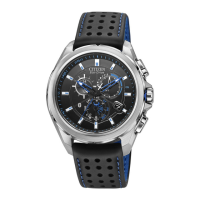2/4
U680 Abbreviated instruction
Checking the power reserve
The function hand indicates the power reserve amount in levels.
Level 3 2 1 0
Indication
Duration
(approx.)
180 - 130 days 130 -20 days 20 - 3 days 3 days ‒
Meaning
Power reserve is
sufficient.
Power reserve is
OK.
Power reserve is
getting low.
Insufficient
charge warning
has started.
Charge immediately
Checking the signal reception result
• This watch receives the time signal at 2:00 AM every day and adjust the time
and calendar automatically. If the 2:00 AM reception was unsuccessful, it tries
signal reception again at 3:00 AM and 4:00 AM.
• The 4:00AM time reception can be changed to other time. Refer to
Setting the
reception time
.
1.
Pull the crown out to position
1
.
2.
Rotate the crown to change the mode to [TME], [CAL] or [RX-S].
3.
Push the crown in to position
0
.
4.
Press and release the lower right button
A
.
The second hand indicates the signal reception result (H/M/L/NO) and
the function hand indicates the signal station (USA/EUR/CHN/JPN) from
which the time signal was received.
Reception result
indication (NO)
Reception result
indication
(H/M/L)
Function hand
• Summer time setting of the home time is indicated on the digital display 2.
(“SMT” and “ON” (or “OFF”) are alternately indicated).
H
Received signals in a very good condition
M
Received signals in a good condition
L
Received signals in a not-good condition
NO
The reception failed.
• “H”, “M” and “L” only indicate the condition for reception, not related to
the reception performance of the watch.
• Try signal reception following the steps in
Receiving the signal manually
(on-demand reception)
if the last reception failed.
5.
Press and release the lower right button
A
to finish the
procedure.
The hands returns to normal.
• It returns to normal indication automatically in about 10 seconds without
pressing the button.
Setting the area of the home time
Choose the area where you usually use the watch to set the home time.
• The watch tries to receive the signal from the station assigned for the area of the
home time (indicated on the digital display 2).
1.
Pull the crown out to position
1
.
2.
Rotate the crown to change the mode to [TME].
3.
Press and release the lower right button
A
or the upper right
button
B
repeatedly to select an area.
• An area name and its time is shown on the digital display 1.
• Pressing and holding the button changes area names continuously.
4.
Press and release both the lower right button
A
and upper
right button
B
at the same time.
5.
Push the crown in to position
0
to finish the procedure.
About the time zone
• The time zone in the table is based on UTC (Coordinated Universal Time).
• Countries or regions may change time zones for various reasons.
Time
zone
Area
name
Representative area
Signal
station
0
UTC
Coordinated
Universal Time
–
0
LON
*London
EUR
+1
MAD
*Madrid
PAR
*Paris
ROM
*Rome
BER
*Berlin
+2
CAI
Cairo
♦
EUR
ATH
*At hen s
JNB
Johannesburg
+3
MOW
*Moscow
RUH
Riyadh
+3.5
THR
Tehra n
+4
DXB
Dubai
+4.5
KHL
Kabul
+5
KHI
Karachi
♦
CHN
+5.5
DEL
Delhi
+6
DAC
Dhaka
+6.5
RGN
Yangon
+7
BKK
Bangkok
+8
SIN
Singapore
+8
HKG
Hong Kong
CHN
BJS
Beijing
+8
TPE
Taipei
JPN
+9
SEL
Seoul
TYO
Tokyo
Time
zone
Area
name
Representative area
Signal
station
+9.5
ADL
Adelaide
♦
JPN
+10
SYD
Sydney
+11
NOU
Noumea
+12
AKL
Auckland
SUV
Suva
-11
MDY
Midway
♦
USA
-10
HNL
Honolulu
-9
ANC
**Anchorage
-8
YVR
**Vancouver
USA
LAX
**Los Angeles
-7
DEN
**Denver
-6
MEX
**Mexico City
CHI
**Chicago
-5
NYC
**New York
YMQ
**Montreal
-4
SCL
Santiago
♦
USA
-3
RIO
Rio de Janeiro
-2
FEN
Fernando de
Noronha
♦
EUR
-1
PDL
*Ponta Delgada
Any
HOM
Depends on the time zone
set.
• USA: the United States of America, EUR: Europe, CHN: China, JPN: Japan
• For an area with * or **, the automatic switching of summer time/standard time
are performed together.
• When using the watch in an area not listed in the table, select an area name in
the same time zone.
• Areas with
♦
mark are out of receivable range and signals cannot be received.
(The watch tries to receive signals from the target signal station though.)
• It may be difficult to receive signals in certain environment where it is hard for
signals to reach.

